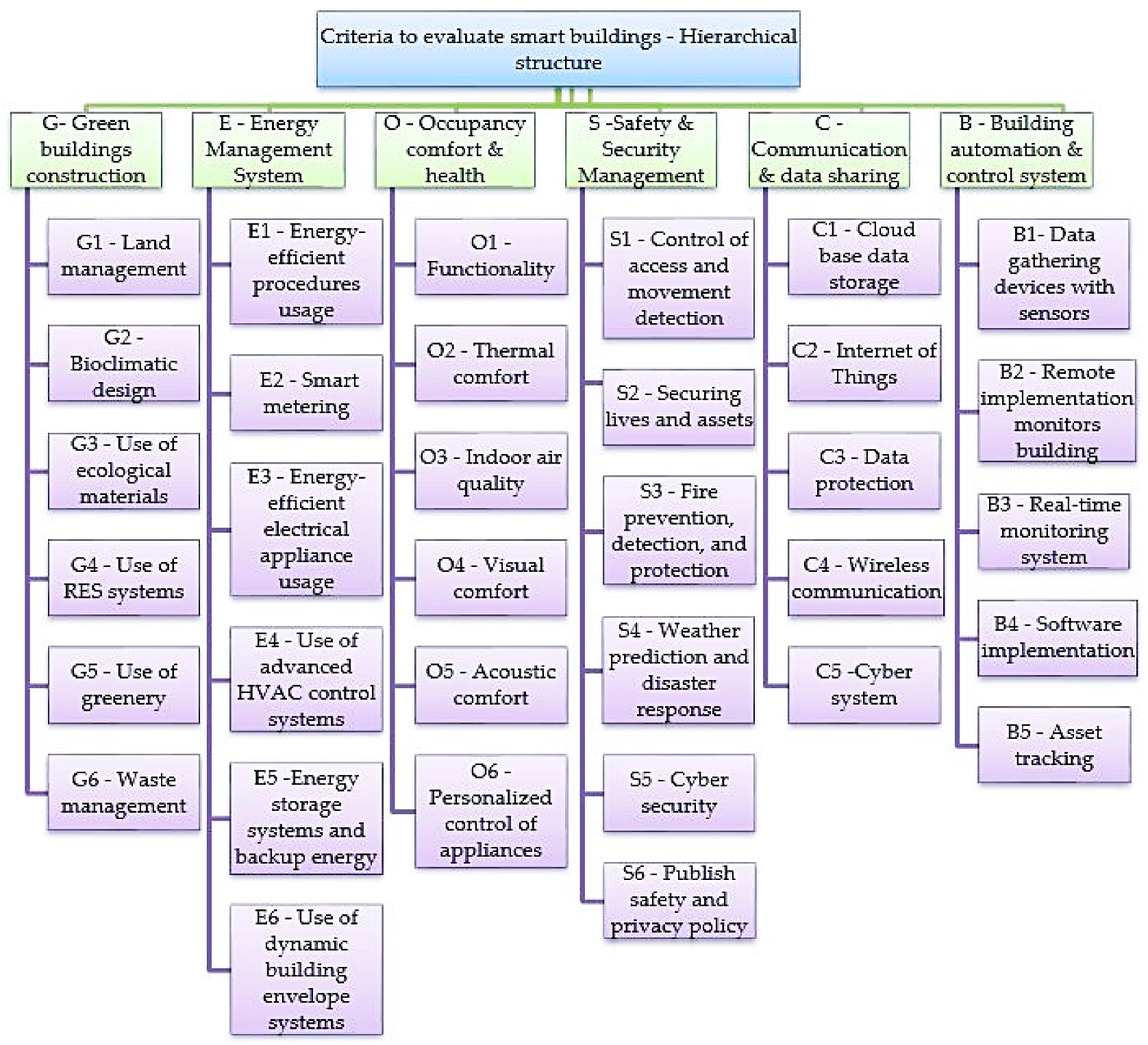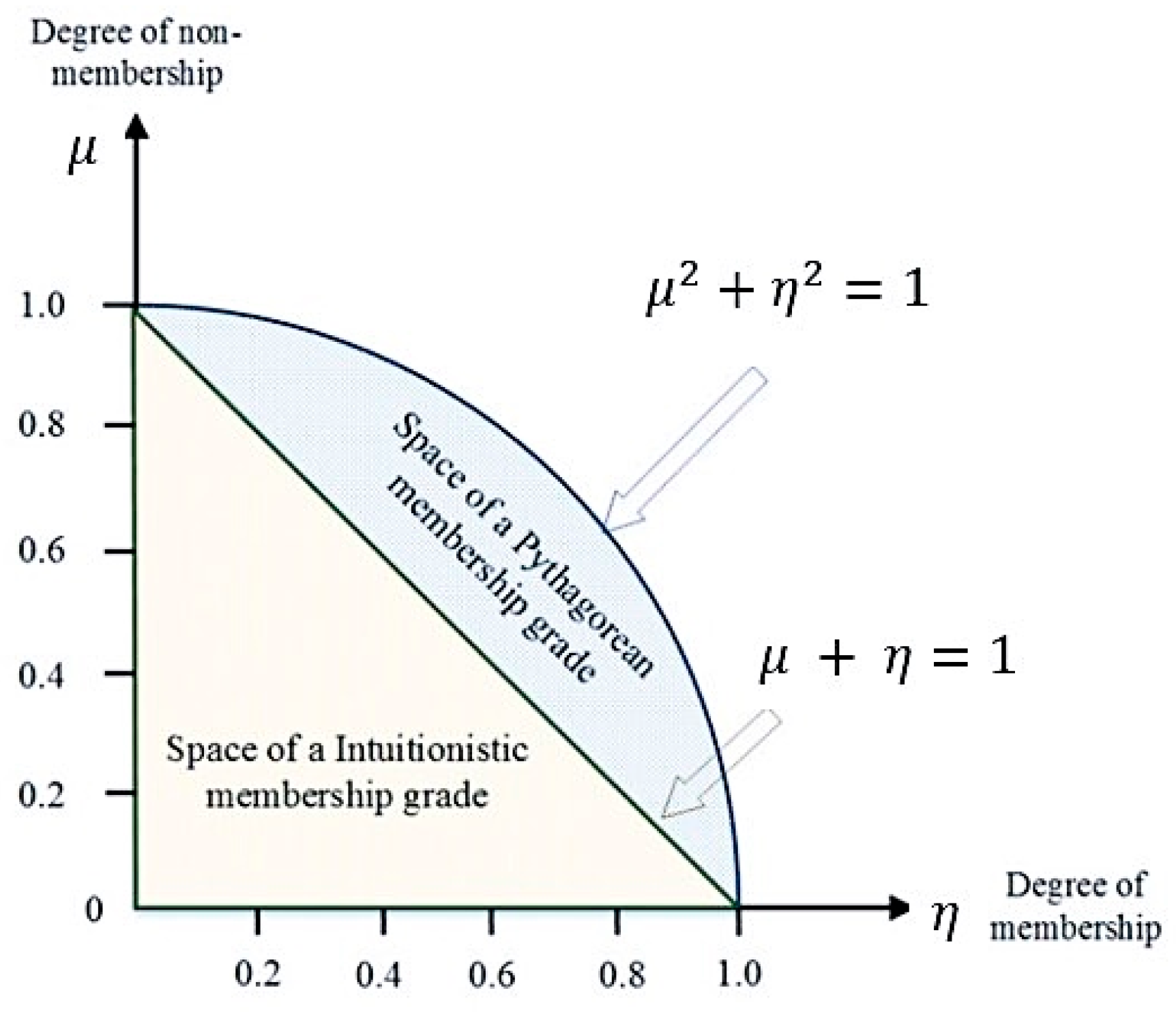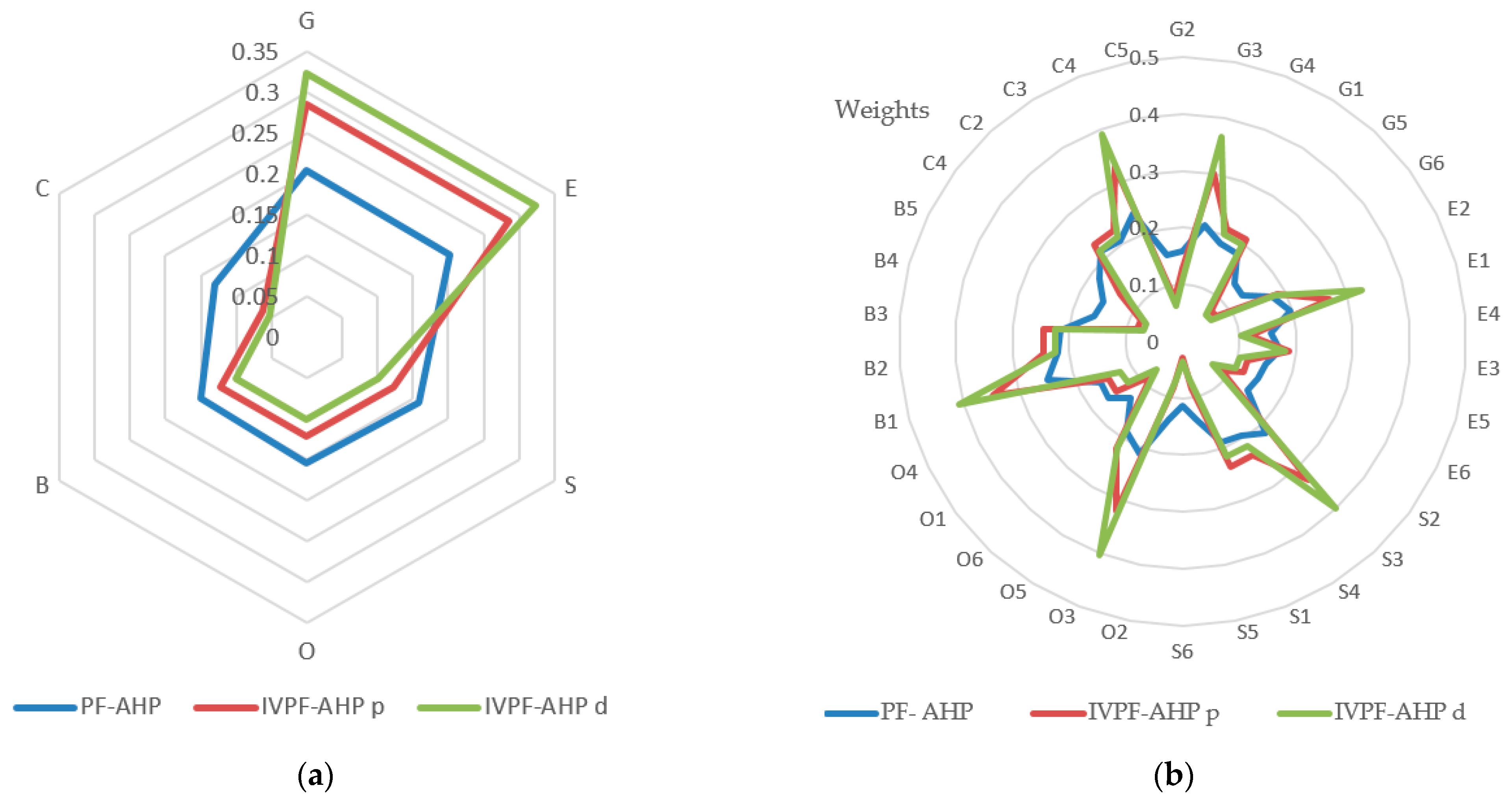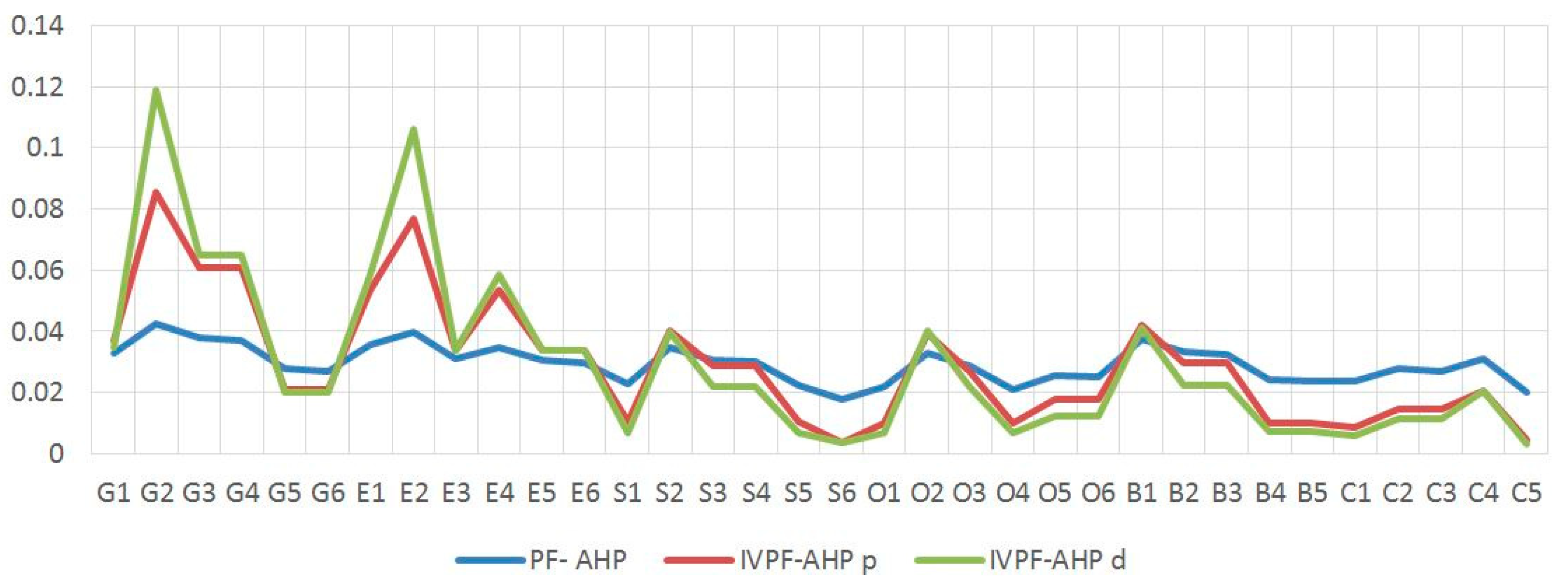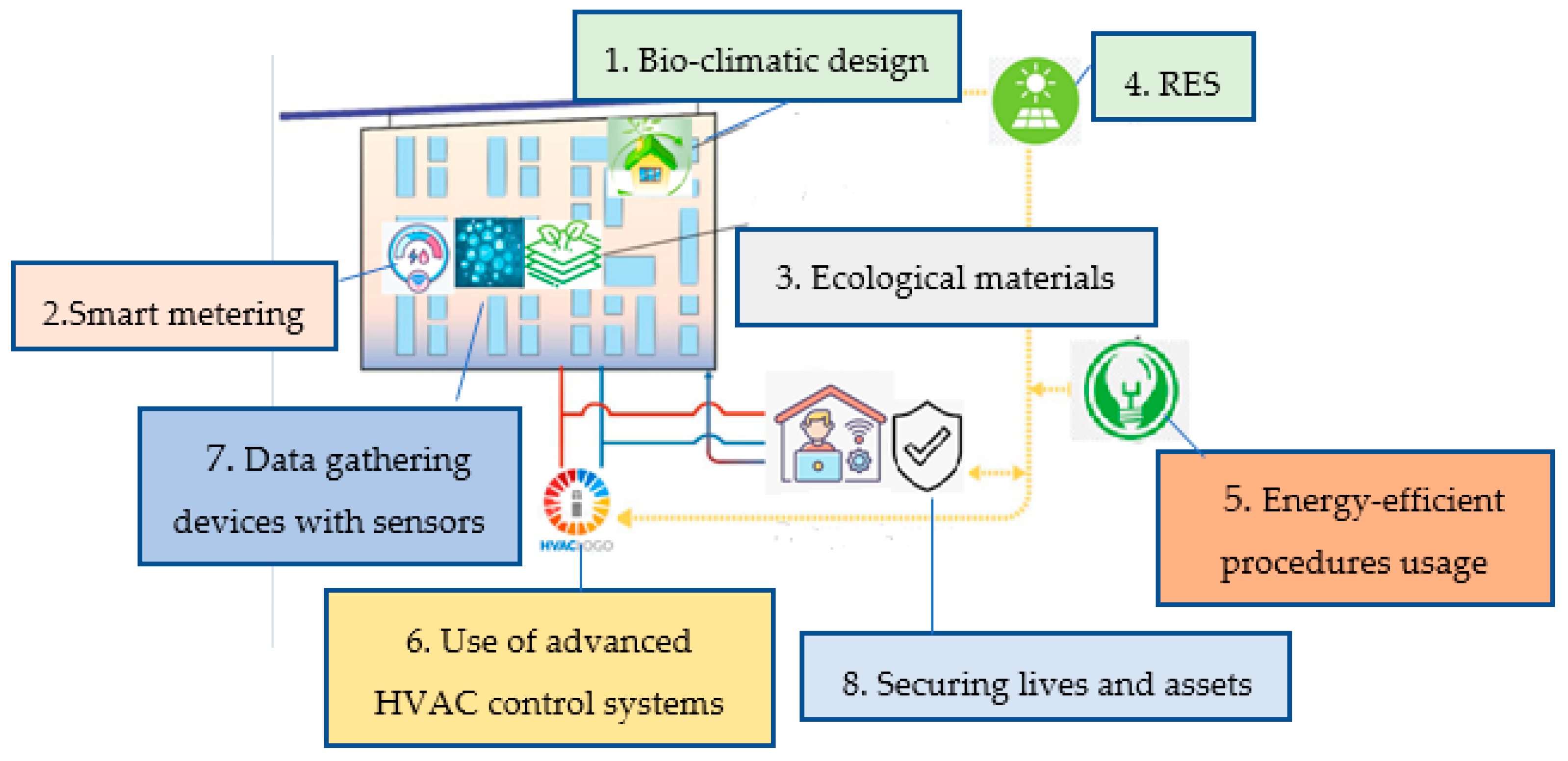1. Introduction
Many facets of sustainable cities are the focus of fashionable urban development initiatives. According to earlier studies, 70% of the world’s population will live in cities by 2050 [
1]. The correlation between sustainability and the requirement for urban places to be livable, robust to global issues, and responsive to their residents was stressed by many researchers who spoke about the creation of forthcoming cities [
2]. Future urban planning should prioritize ecological comfort, energy efficiency, and minimal negative environmental impact. The construction sector is developing rapidly and will continue to grow—the equivalent of the size of Paris—every week [
3]. Considering that the built environment affects a large part of global greenhouse gas emissions, necessary planned actions had to be taken in this area. For the European construction sector, all new buildings must henceforth be buildings with near-zero energy consumption, as a significant reduction of greenhouse gas emissions in the built environment is necessary.
The vision of a “smart city”, which is emerging as a result of the fourth industrial revolution in recent decades, is developing by utilizing cutting-edge Information and Communications (IC) technology to improve people’s quality of life. It makes the current environment more robust and self-sufficient to sustainably meet the above listed requirements by transforming it on an ecological, economic, cultural, and social level [
4]. The idea of a “smart city” has permeated many further elements of urban life, including the economy, transportation, environment, society, and living conditions [
5]. Strenuous changes in city life, which occur daily, have prompted us to consider ways to build a more sustainable society that can withstand the rapid development of our environment [
6]. Through the use of data sensors, public platforms for e-government and e-commerce, the ongoing development of traffic, the digitization of cultural heritage, and virtual tours, cutting-edge technologies based on big data, Internet of Things platforms, and remote sensing images have become part of people’s everyday lives in modern and advanced urban infrastructure [
7,
8]. The new Building Management System (BMS) will significantly contribute to the market’s growth through the proliferation of the Internet of Things (IoT), Artificial Intelligence (AI), Virtual Reality (VR), and Business Information Modeling (BIM). The advancement of the construction industry as a consequence of the use of IC technologies has an impact on the development of the idea of “smart buildings”. Sustainable buildings are attractive and healthy for building users, while at the same time, they have a low environmental impact during their lifetime and fulfil their social and cultural potential. At the same time, another concept of the so-called smart or intelligent building has emerged, driven by the rapid growth of technology connected to the IoT. Awareness of the importance of developing smart buildings has increased in the last few decades. Modern smart buildings have their roots in the mechanical engineering development of self-regulating ecological systems in the 18th and 19th centuries. However, it was not until the end of the 20th century, with the use of digital computers and inventions, that the concept of smart buildings expanded to integrate technologies into various building systems. Buildings with cutting-edge Heating, Ventilation, and Air-Conditioning (HVAC) systems, enhanced materials, and significant energy savings are now considered “smart buildings”. Facilities in the EU account for 40% of energy use, according to the European Commission [
9]; therefore, the “smart buildings” idea is heavily centered on energy minimization with the enhancement of user experience.
A standard, widely acknowledged definition of a “smart building” does not exist. Numerous theoretical and empirical findings from academics and industry professionals have helped clarify the transformation of conventional buildings into more adaptable and efficient ones. Buildings are increasingly required to adapt to climate change to meet environmental performance standards and advance “smart” solutions [
10]. A “smart building” integrates and considers intelligence, enterprise, control, and materials, as well as construction, as a whole building system, according to Buckman et al. [
11]. For supervision and control, these facilities have centralized automation and control systems. Sound and light data can be collected using sensors and tracks to minimize energy use in different microclimate conditions [
12]. The European Performance of Buildings Directive (EPBD), which was revised to include “smart” readiness indicators to enable rating of the smartness of the structures, established the idea of “smart” buildings. The Global e-Sustainability Initiative’s SMARTer2030 report also provides a technology outlook for “smart” buildings in 2030, highlighting the influence of IC technologies to reach better levels of energy efficiency [
13]. A green building includes construction plans, production, transportation, and use of sustainable materials, with minimal waste and maintenance [
14]. With green building certification systems, a wide range of smart building technologies are now available to create more sustainable and intelligent buildings. Smart buildings imply the use of innovative technologies and processes, as well as design solutions, for the development of buildings that are comfortable and safe for their tenants and, at the same time, economical for their owners [
15]. Thermal comfort, visual comfort, and indoor air quality are three fundamental variables that assess the standard of living inside a building environment [
16]. Energy evaluation is essential for owners and tenants, as it can reveal how much energy is used. As a result, energy evaluation ought to serve as inspiration to find possible savings. Hence, the smart use of energy in buildings can assist in lowering both energy use and costs [
17]. “Smart” decisions in this area reduce energy costs and carbon emissions from the building sector [
18,
19,
20].
New challenges are emerging, and whether it is called “green building”, “sustainable building”, or “smart building”, it is clear that we are living in the era of information technology and that old-fashioned, disconnected, and unsustainable buildings are no longer sustainable. Smart performance development in architectural object design and construction influences smart cities’ development as urban environments. Evaluating the smartness of architectural objects, regardless of their purpose, is significant for creating the possibility to compare their performance from the aspect of sustainable construction. The concept defined by the indicators in the paper has an extensive impact on the aspect of financial construction and the maintenance of buildings, the comfort of staying in the building, and the degree of energy consumption, and the proposed evaluation system would have practical application when making decisions about the choice of the most optimal design solution before its development to the executive project.
When we talk specifically about buildings of public purpose, in contrast to residential architecture, they are characterized by the functional plan complexity, the significant area they occupy, and their contents (cultural facilities, educational facilities, health facilities, commercial facilities, and business facilities, catering facilities). The evaluation of the proposed performance is vital when selecting satisfying office space for rent or purchase, in the case of already built facilities for business purposes, or in the construction of facilities for the accommodation of guests (hotels, hostels, resorts, etc.). In the case of museums and galleries, the evaluation of the smartness of buildings is vital due to the maintenance of adequate HVAC conditions in the case of educational facilitie, schools, kindergartens, colleges, etc. It is crucial to select a design solution that could provide users with a comfortable stay and low energy consumption.
Speaking specifically about buildings of public purpose, in contrast to residential architecture, they are characterized by the complexity of the practical plan and the significant area they occupy, depending on the process of creating smart cities, a notable role played by state-initiated projects and strategies, investment programs for new construction and programs for sustainable renovation and energy rehabilitation, which are often aimed primarily at facilities intended for the youngest (kindergartens and elementary schools), facilities of health institutions and gerontological centers, as objects of public purpose.
The research started by reviewing the existing definitions and frameworks of the smart building to gain the key features and understanding of concepts, resulting in a concise definition that can describe the new building concept and a list of indicators to form the basis of an assessment framework. The assessment of a building’s architectural smartness is a complex question. It is connected to the newly developed technologies that have been used, but it also depends on how the technologies are combined and the kind of system they enhance. The most recent machine learning algorithms can be used and applied as a decision support system for various assessments in construction [
21]. This paper examines the issue of rating the smartness of public buildings using multi-criteria decision-making. The proposed study would prioritize the requirements for “smart” building development using the IVPF-AHP to identify the best indicators for transforming conventional public buildings into smart ones. A total of 34 indicators are selected for six capital sustainability and smartness dimensions, representing a holistic approach. The outcomes of three methods—two IVPF-AHP and one PF-AHP—are compared and discussed.
The structure of the paper is as follows. After the Introduction,
Section 2 illustrates the assessment of the smartness of buildings by defining indicators and provides a hierarchical structure and the methodology of IVPF-AHP.
Section 3 provides results with the PF-AHP and two approaches of IVPF-AHP methods, and the obtained results discussion related to the ranking of sub-criteria. The study is concluded in
Section 4, which also suggests some areas for further research.
2. Materials and Methods
The steps in the research framework are as follows, because of the complexity of the intended study goal and the wide range of factors that affect the creation of “smart” buildings:
Defining and implementing the indicators connected to the construction of “smart” public buildings;
Formulating and utilizing the Pythagorean Fuzzy Analytic Hierarchy Process (PF-AHP);
Pythagorean Fuzzy Analytic Hierarchy Process (PF–AHP)
Ranking indicators as a foundation for creating a scoring system for the smartness of public buildings.
Multi-criteria decision-making methods are applied in many research areas [
22,
23]. The evaluative role of experts in complex decision-making problems requires a fuzzy logic theory when dealing with various uncertainties. A significant and challenging issue that also arises when devising solutions to the concerns covered in this study is the subjectivity and uncertainty of the evaluators’ assessments of the evaluation criteria. The Fuzzy Set Theory (FST), presented by Zadeh [
24], is applied to solving many decision-making problems. This theory’s various iterations have been developed over a long period and successfully applied to resolve various decision-making problems.
Pythagorean Fuzzy Sets (PFS), a brand-new intuitionistic fuzzy sets extension, is one of these additions [
25,
26].
There are numerous studies in the construction industry employing the AHP for ranking alternatives for the selection of construction contractors and subcontractors [
27], the choice of the project implementation process [
28], or the selection of architectural consultants [
29]. In addition, the AHP has been used for determining selection criteria weights for the choice of bridge elements for maintenance [
30], dispute resolution methodology [
31], project selection based on risk assessment [
32], and more recently, for the choice of contract types [
33] and project procurement systems [
34]. An overview of the application of the AHP in construction is given in [
35].
The use of Interval methods facilitates the work of experts in the sense of facile determination in the classification of the performed grades, as was performed in existing research [
36,
37]. It is easier for an expert to choose an interval membership (non-membership) than a corresponding crisp value.
2.1. Building Smartness Assessment: Defining Indicators
Understanding the characteristics and specific criteria that comprise smart buildings is quite challenging, given the development of new technologies and is, therefore, the subject of much research [
36,
37,
38,
39,
40]. A literature review is carried out to select criteria and sub-criteria for determining the smart buildings indicators more systematically at the beginning of the research. Indicators have been divided into six main groups, as suggested by Gunatilaka et al. [
36]. Existing tools for evaluating buildings have focused mainly on environmental aspects [
41], so the applicability of such a criterion in determining the building’s smartness level is questioned. Most of the green building evaluation schemes that are widely used (Globes, Leadership in Energy and Environmental Design, Building Research Establishment Environmental Assessment Method, Green Rating for Integrated Habitat Assessment, Green Mark, Comprehensive Assessment System for Built Environment Efficiency, and Green Star) are highly focused on assessing the entire life cycle and ensuring long-term environmental benefits, but at the same time, can be criticized for their unequal treatment of the three pillars of sustainability [
42].
Table 1 lists and describes the major criteria categories and the literature review findings. The table indicates the most significant factors that examine different perspectives of the smartness assessment framework from which the system of classification criteria has been created.
The design and development of smart buildings is a complex task. Every smart building is unique, and achieving reliability and real-time adaptations to environmental conditions are some of the challenges in developing smart buildings [
58]. Different domains and constituent variables associated with building smartness are identified in
Table 1 by the literature review. In the selection of indicators, an agreement is reached based on the given literature. Twenty-eight experts participated in the selection of indicators and evaluation. The proposed literature was the basis for the sub-criteria selection. The professional profile of experts is in
Figure 1a and work experience is in
Figure 1b.
The hierarchy structure of the indicators affecting the smartness assessment framework of buildings is presented in
Figure 2. The experts answered the question: “How much more important is criterion x compared to criterion y for achieving satisfactory Green Buildings Construction?”. The criteria used in a decision problem are compared for each level, and the the obtained values are saved in matrix form.
2.2. Implementing the Pythagorean Fuzzy Analytic Hierarchy Process
Atannasov [
59] proposed intuitionistic type-2 fuzzy sets, which were later upgraded to Pythagorean Fuzzy Sets (PFS) by Yager [
60]. Although the membership degree and non-membership degree assigned by experts in PFS may add up to more than 1 (
Figure 3), their squares’ sum must be less than or equal to 1 [
61]. The AHP method, with Pythagorean fuzzy sets, can be used to eliminate uncertainty and ambiguity.
With PFS, when creating comparison matrices, the comparison is made on two aspects—membership and non-membership, unlike the AHP method, where the comparison is made only by one aspect—significance. The field of application of PFS has increased compared to the intuitionistic approach.
2.2.1. Preliminaries
Definition 1. Let be the universal set. A Pythagorean fuzzy set is an object having the form [62], as in Equation (1) where the function : [0, 1] defines the degree of membership and : [0, 1] defines the degree of non-membership of the element to respectively, and, for every , it holds the Equation (2) The degree of hesitancy condition is Equation (3) For a PFS , the pair is called a Pythagorean Fuzzy Number (PFN). For convenience, the pair is often denoted by where
Definition 2. For two PFNs ,
and scalar λ > 0, the elementary operations are defined [63] by Equations (4)–(7): Definition 3. Let be a collection of PFNs. Then, their aggregated value using Pythagorean Fuzzy Weighted Averaging () operator is performed [64] by Equation (8)where is the weight vector of with and Definition 4. The defuzzification formula for a Singular Value Pythagorean Fuzzy Number (SV-PFN) is given by Equation (9), as in [65]. The alternatives are ranked based on alternative scores using Equation (9). The next few definitions can be seen in the papers [
66,
67].
Definition 5. An Interval-Value Pythagorean Fuzzy Set (IV-PFS) , on the universal set , is defined by Equation (10)where ,
and Similar to PFSs, for each element
, its hesitation interval relative to
is given by Equation (11) as
Especially, for every if then, IVPFS reduces to an ordinary PFS.
For an IV-PFS , the pair is called an Interval Valued Pythagorean Fuzzy Number (IV-PFN). For convenience, the pair is often denoted by , where
Definition 6. Let be an interval-valued PF. The hesitancy degree of the lower and upper points of and respectively, can be calculated by Equations (12) and (13) Definition 7. Let and be any two Interval Valued Pythagorean Fuzzy Numbers (IV-PFNs) and > 0. Then, the arithmetic operations are defined as follows in Equations (14)–(17) Definition 8. Let be any collection of IV-PFNs and be the weight vector of such that and . Then, Interval Valued Pythagorean Fuzzy Averaging (IV-PFA) operator is defined by (18) where Definition 9. Let and be interval valued PFNs and and are the hesitancy degrees of lower and upper points of the and , respectively. The distance between and can be calculated by (19), as in [68] Definition 10. Let be an interval-valued PFN and and are the hesitancy degree of the lower and upper points of , then, the defuzzifying procedure of this number is calculated by (20), as in [69] 2.2.2. Pythagorean Fuzzy Analytic Hierarchy Process (PF–AHP)
The classic AHP method compares only according to the importance of indicators. In the PF-AHP method, the comparison is made for two criteria: membership and non-membership.
Figure 4 shows the steps of PF–AHP.
2.2.3. Interval Valued Pythagorean Fuzzy AHP (IVPF-AHP) with Differences (IVPF-AHP d)
The IVPF-AHP provides an additional possibility of using intervals, giving more freedom to experts in creating comparison matrices. The IVPF-AHP d method, in which defuzzification is performed using differences (see Step 5), consists of the following steps, shown in
Figure 5:
First, the experts are expected to express their opinion and give ratings concerning the identified indicators according to the problem in pairs. The language variables are shown in
Table 2. Pythagorean Linguistic Scales of Fuzzy Numbers are defined by two parameters of PFN: membership and non-membership functions.
The expert assessment aggregation is obtained by the averaging method. First, the corresponding crisp value for each expert has been attached based on the linguistic assessments. Since each expert has weights the aggregated value has been obtained by the formula According to this value, by rounding to the nearest integer, the corresponding value of the fuzzy number is obtained.
The decimal scale used in the PF-AHP method, instead of the integer values used in the AHP method, is necessary to satisfy the inequality that the sum of the squares of the membership and non-membership functions must be less than 1.
2.2.4. Proposed Interval Valued Pythagorean Fuzzy AHP (IVPF-AHP p)
Following the PF-AHP steps presented in
Section 2.2.1, we have developed a suitable IVPF-AHP p, whose steps are given as follows:
Step 1. Define the goal, the final set of criteria and sub-criteria and form a hierarchical structure
Step 2. Define linguistic expressions using Interval Valued Pythagorean Fuzzy numbers.
Step 3. Create Interval Valued Pythagorean Fuzzy comparison matrices from decision makers using linguistic expressions.
Step 4. Check the consistency of the Interval Valued Pythagorean Fuzzy comparison matrices of criteria employing Saaty’s classical consistency analysis. The method is consistent if the corresponding AHP method is consistent.
Step 5. Use the IVPF-AHP approach to determine the criteria weights. Determine each row’s geometric mean. The procedure is carried out in two steps. Before obtaining root values, Pythagorean values for each criterion are multiplied.
Step 6. Defuzzify the obtained weights and normalize them to 1. In the defuzzification procedure, we use Equation (20).
The proposed method is a natural extension of PF-AHP to IVPF-AHP.
3. Results and Discussion
The algorithms outlined in
Section 2.2.2,
Section 2.2.3 and
Section 2.2.4 are applied in this section. Matrices of pairwise comparison PFNs and interval IVPFNs are made respecting experts’ opinions. The corresponding Pythagorean fuzzy comparison matrices are created following the markings in
Table 2. The hierarchy of problems is defined under the goal based on the indicators given in
Figure 1. Based on Saaty’s classical consistency analysis, one calculates matrix consistency index
and consistency index
, where
is the greatest eigenvalue of the matrix of dimensions
n, and
is the random index given by:
The values of
CR < 0.1 indicate that the comparison matrices are consistent. Pythagorean fuzzy pairwise comparison matrices of main criteria and sub-criteria in the PF-AHP method are shown in
Table 3,
Table 4,
Table 5,
Table 6,
Table 7,
Table 8 and
Table 9.
Figure 6 gives a graphic representation of the weights of criteria and sub-criteria. It can be seen that the weight values of the proposed IVPF-AHP method (IVPF-AHP p) given in
Section 2.2.4 are between the PF-AHP method and IVPF-AHP method, with differences (IVPF-AHP d) given in
Section 2.2.3.
Final weights of sub-criteria in the smartness assessment of buildings are shown in
Figure 7 for all three observed methods.
The obtained results indicate the dominance of two sub-criteria in the algorithm, G2 and E2. Additionally, the first three indicators are the same for all three methods, and two interval methods have overlaps in the order of the first seven indicators. The final ranking results, obtained by the consistent application, are shown in
Table 17.
The rankings of the “smart” building-related indicators presented in
Table 17 are the basis for creating a mechanism for a scoring system for the smartness of public buildings. The main criteria level indicators under groups G (green building construction) and E (energy management systems) are recognized by experts as a requirement for the development of “smart” buildings for public use. The obtained results show that bio-climatic design of the building (G
2), smart metering (E
2), use of ecological materials (G
3), use of renewable energy sources (G
4), energy-efficient procedures usage (E
1), use of advanced HVAC control systems (E
4), data gathering devices with sensors (B
1) and securing lives and assets (S
2) possess an essential influence on the creation of “smart” buildings for public use. The ranks of the last-ranked indicators differ for all three methods. It turned out that the publish safety and privacy policy (S
6) and cyber system (C
5) were ranked worst.
The performance defined by the indicators in the paper has an impact on the financial aspect of construction and maintenance of buildings, the comfort of staying in the building, and the degree of energy consumption, and the proposed evaluation system would have practical application when making decisions about the choice of the most optimal design solution before its development in the executive project.
In the process of creating smart cities, an important role is played by state-initiated projects and strategies, investment programs for new construction, and programs for sustainable renovation and energy rehabilitation, which are often aimed primarily at facilities intended for the youngest (kindergartens and elementary schools), facilities of health institutions and gerontological centers, as objects of public purpose.
To compare the lists of ranked criteria, using the three mentioned methods, we use Spearman’s rank correlation coefficient [
70] by Equation (21)
A total of
N elements are ranked, and
and
are ranks of the element
k in the compared rankings. The comparison of similarities used a WS coefficient was introduced to analyze the ranking similarity [
71] by Equation (22), where
By applying Equations (21) and (22), all compared results are presented in
Table 18, and since
{
} = 0.95783, it may be said that all rankings have a notable similarity.
The scoring system applies only to public purpose buildings, which means that for other types of buildings—residential or industrial—a new ranking would have to be created, with the same and(or) partially changed indicators, depending on the purpose of the buildings. Previous research on the adoption indicators has been performed, and the division of indicators in this way more or less exists and is the result of scientific research. In this paper, unlike others, they are ranked exclusively for public purpose objects, and their ranking is universal for all types of public buildings.
The scoring system for assessing the level of smartness of public-use buildings is directly obtained from the weights. For ease of use, it can be multiplied by 100 and rounded to the nearest whole number. To avoid the narrow scale range of PF-AHP and the too-wide range in IVPF-AHP d, we create a scoring model by the arithmetic mean of the three methods presented. The scoring results are in
Table 19.
Table 19 presents the framework for the implementation of the scoring system. First, the evaluator must check whether the building meets the criteria and sub-criteria from the scoring system. The sum of all the points given for the indicators is the final result, indicating the level of smartness of the building, based on which, decisions can be reached regarding strategies to improve or maintain the level of smartness.
It can be seen from the final scoring in
Table 19 that the points assigned to the indicators obtained using the IVPF-AHP p method are between the scores of PF-AHP and IVPF-AHP d. The practical interpretation is that the scores are in a smaller range, and there is less difference in the scoring of the indicators of the PF-AHP method. On the other hand, the scores of the IVPF-AHP method belong to a widening range and favor the key indicators. The application of the proposed method is more compromised.
Based on the received final rankings, we created an integrated model of a smartness assessment framework of buildings, shown in
Figure 8. The model is based on the identification of influential factors.

